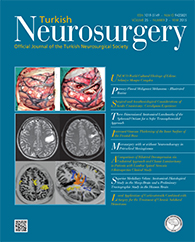2Sar Hospital, Clinic of Neurosurgery, Rize, Turkey
3TOBB University of Economics and Technology, Ankara, Turkey
4Neurospinal Academy, Department of Neurosurgery, Istanbul, Turkey
5Celal Bayar University, School of Medicine, Department of Neurosurgery, Manisa, Turkey DOI : 10.5137/1019-5149.JTN.8710-13.1 AIM: Bilateral decompression via unilateral approach is one of the minimally invasive methods used for degenerative spinal stenosis. The aim of this retrospective study was to observe the clinical and radiological results of classic laminectomy and bilateral decompression via unilateral approach applied for lumbar stenosis.
MATERIAL and METHODS: The data of 40 patients who underwent surgical treatment for lumbar spinal stenosis with different techniques was reviewed retrospectively. The patients were divided into 2 groups according to the surgical technique. In the first group, patients underwent classic laminectomy, while in the second group patients underwent bilateral decompression via unilateral approach. Preoperative and postoperative computed tomography section areas of both groups were examined. Visual analogue scale (VAS) was used to evaluate low back and leg pain in preoperative and postoperative 1, 6, and 12 months. The two groups were compared in respect of surgery time and bleeding.
RESULTS: In both groups, postoperative low back and leg pain VAS scores declined compared to the preoperative condition. Low back pain VAS scores were lower at postoperartive 1, 6, and 12 months. The bleeding was higher in the 1st group, whereas the surgery time was higher in the 2nd group.
CONCLUSION: Bilateral decompression through unilateral approach is an effective method without instability effect, which provides sufficient decompression in the degenerative stenosis and increases patient comfort in the postoperative period.
Keywords : Lumbar stenosis, Unilateral approach, Minimally invasive




